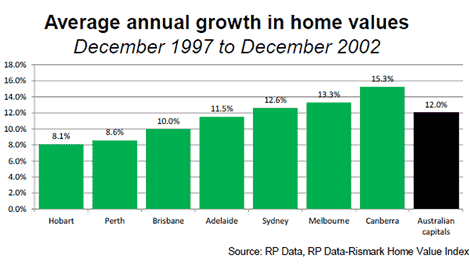Australian property capital growth slows to 1.9% per year over past five years: Cameron Kusher
Capital city home values have increased at an average annual rate of just 1.9% over the past five years, which is significantly lower than the previous two five-year periods, according to RP Data's Cameron Kusher.
It reflects changing consumer attitudes towards debt following the global financial crisis.
Looking at three five-year periods, the research by the senior research analyst at RP Data indicated the strongest growth period as 1997 to 2002 when the annual growth was 12%.
Kusher argues the rate of capital growth in the Australian housing market has been slowing over some considerable time.
"The global financial crisis, and the subsequent changes in consumer attitudes that it has led to, has largely impacted the results of the most recent five years.
"However, it remains difficult to argue that value growth would have been as strong over the past five years as the previous five years even without the financial crisis.
"As the cost of buying and selling continues to increase, albeit at a much slower pace, it seems unlikely that capital gains in the housing market will return to those levels enjoyed between 1997 and 2002 and will be more reflective of conditions over the most recent five years," Kusher says.
Darwin triumphed as the city to record the strongest growth in home values over the past five years, increasing at an average annual rate of 4.1%.
But Hobart, Brisbane and Perth each recorded value falls on an annual average basis, at a rate of -1.9%, -0.8% and -0.4% respectively.
From December 2002 to December 2007, the overall performance of the housing market was comparatively stronger, and over the five-year period capital city home values increased at an average annual rate of 8.4%.
It was almost 4.5 times greater than growth throughout the most recent five years.
Excluding Sydney, between 2002 and 2007, every capital city housing market recorded superior levels of average annual value growth compared with the overall performance over the most recent five years.
Kusher notes during this period every city other than Sydney recorded average annual value growth more than 2.5 times greater than the most recent five-year period.
"Sydney’s housing market performance has actually been stronger over the most recent five years than it was between 2002 and 2007," he says.
Click to enlargeFor the period 2002 to 2007, the standout housing markets were Perth (19.4%pa) and Hobart (17.2%pa), however, the latest data confirms that both of these cities recorded value falls on an average annual basis over the past five years.
"It is worth noting that growth in capital city home values over the five-year period from 1997 to 2002 was greater than for the two following five-year periods; however, this was largely the result of higher levels of value growth over this time in the nation’s two largest markets, Sydney and Melbourne.
"Over this five-year period, capital city home values increased at an average annual rate of 12%," Kusher says.
Overall, each capital city recorded average annual capital growth in excess of 8% per annum over the period 1997 to 2002, highlighting the comparatively stronger market conditions at that time.
Looking more specifically at the average annual growth in values of detached houses as opposed to units, Kusher notes that historically, it is easy to see that houses have experienced stronger value growth than units. Over the 15 years to December 2012, capital city house values have increased at an average annual rate of 7.6%, compared with 6% for units.
And while the unit market underperformed the detached house market over the longer term, unit values appreciated at a faster pace over the past five years.
Kusher says that the recent superior performance is likely due to a range of factors, most notably:
• The relative affordability of units compared to detached houses;
• Changing lifestyle preferences, with owner occupiers more accepting of units, particularly in inner-city areas;
• The fact that units are typically located closer to the city centre and within suburbs that owner occupiers aspire to own houses but can’t realistically afford to do so; and
• The fact that units are typically more attractive to investors than detached houses because they enjoy higher rental yields.
Last week RP Data reported capital city home values fell over consecutive years, down 3.8% in 2011 and 0.4% in 2012.


